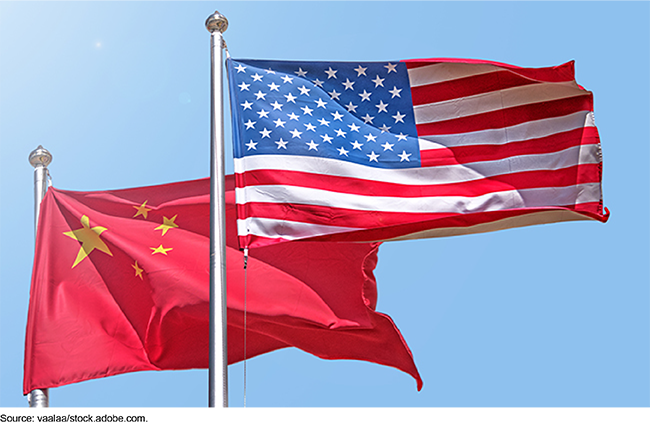U.S.-China Trade: USTR Should Fully Document Internal Procedures for Making Tariff Exclusion and Extension Decisions
Fast Facts
In response to unfair trade practices, the U.S. imposed tariffs of up to 25% on imports from China. From July 2018-Dec. 2020 these imports amounted to $460 billion. U.S. firms affected by the tariffs could ask to be excluded from them. The Office of the U.S. Trade Representative received requests for over 53,000 exclusions.
USTR reviewed exclusion requests on a case-by-case basis—denying most because firms didn't show severe economic harm or demonstrate that a product in their supply chain was only available from China. USTR didn't fully document its procedures, which we recommended doing to ensure it reviews any future requests consistently.

Highlights
What GAO Found
The Office of the U.S. Trade Representative (USTR) developed a process in July 2018 to review tariff exclusion requests for some imported products from China and later developed a process to extend these exclusions. From 2018 to 2020, U.S. stakeholders submitted about 53,000 exclusion requests to USTR for specific products covered by the tariffs. USTR's process consisted of a public comment period to submit requests, an internal review, an interagency assessment, and the decision publication. USTR documented some procedures for reviewing exclusion requests. However, it did not fully document all of its internal procedures, including roles and responsibilities for each step in its review process. GAO reviewed selected exclusion case files and found inconsistencies in the agency's reviews. For example, USTR did not document how reviewers should consider multiple requests from the same company, and GAO's case file review found USTR performed these steps inconsistently. Another case file lacked documentation to explain USTR's final decision because the agency's procedures did not specify whether such documentation was required. Federal internal control standards state that agencies should document their procedures to ensure they conduct them consistently and effectively, and to retain knowledge. Without fully documented internal procedures, USTR lacks reasonable assurance it conducted its reviews consistently. Moreover, documenting them will help USTR to administer any future exclusions and extensions.
USTR evaluated each exclusion request on a case-by-case basis using several factors, including product availability outside of China and the potential economic harm of the tariffs. According to USTR officials, no one factor was essential to grant or deny a request. For example, USTR might grant a request that demonstrated the tariffs would cause severe economic harm even when the requested product was available outside of China. USTR denied about 46,000 requests (87 percent), primarily for the failure to show that the tariffs would cause severe economic harm to the requesters or other U.S. interests (see figure). Further, USTR did not extend 75 percent of the tariff exclusions it had granted.
USTR's Primary Reasons for Denying Exclusion Requests for Section 301 Tariffs on Products from China, 2018-2020

Note: Totals may not sum due to rounding.
Why GAO Did This Study
In July 2018, USTR placed tariffs on certain products from China in response to an investigation that found certain trade acts, policies, and practices of China were unreasonable or discriminatory, and burden or restrict U.S. commerce. As of December 2020, the U.S. imposed tariffs on roughly $460 billion worth of Chinese imports under Section 301 of the Trade Act of 1974, as amended. Because these tariffs could harm U.S. workers and manufacturers that rely on these imports, USTR developed a process to exclude some products from these additional tariffs. U.S. businesses and members of Congress have raised questions about the transparency and fairness of USTR's administration of this process.
GAO was asked to review USTR's tariff exclusion program. This report (1) examines the processes USTR used to review Section 301 tariff exclusion requests and extensions and (2) describes how USTR evaluated those tariff exclusion requests and extensions, and the outcomes of its decisions.
GAO analyzed USTR's public and internal documents relating to the exclusion and extension processes, including 16 randomly selected nongeneralizable case files, and data from USTR and the U.S. Census Bureau. GAO also interviewed agency officials.
Recommendations
GAO recommends that USTR fully document the internal procedures it used to make Section 301 tariff exclusion and extension decisions. USTR concurred with these recommendations.
Recommendations for Executive Action
| Agency Affected | Recommendation | Status |
|---|---|---|
| Office of the U.S. Trade Representative | The U.S. Trade Representative should fully document the internal procedures used to make tariff exclusion decisions for the Section 301 tariffs on products from China. (Recommendation 1) |
In February 2022, USTR developed internal procedures that describe the steps they took to review exclusion requests and detail the roles and responsibilities for the process. Most importantly, USTR's procedures now describe steps in the internal review process not previously documented, such as how USTR reviewed multiple requests from the same company. By taking these steps, USTR can help policymakers and other external parties understand how its process granted or denied exclusion requests. Moreover, USTR will be able to administer any tariff exclusion programs in the future with more consistent procedures.
|
| Office of the U.S. Trade Representative | The U.S. Trade Representative should fully document the internal procedures used to make tariff extension decisions for the Section 301 tariffs on products from China. (Recommendation 2) |
In February 2022, USTR developed internal procedures that fully describe the steps they took to review potential extensions and detail the roles and responsibilities for the process. By taking these steps, USTR can help policymakers and other external parties understand its process for extending tariff exclusions. Moreover, USTR will be able to administer any tariff exclusion programs in the future with more consistent procedures.
|
